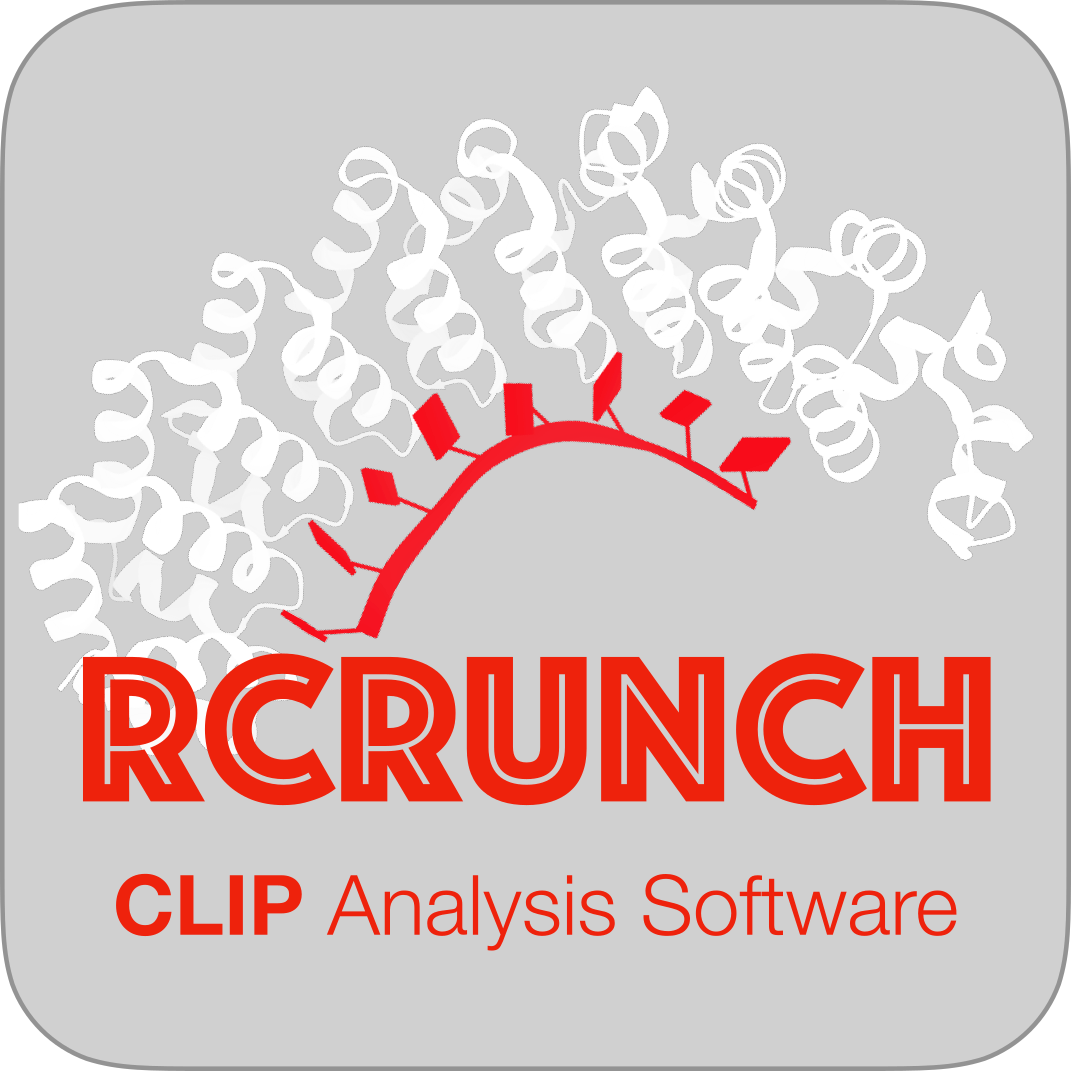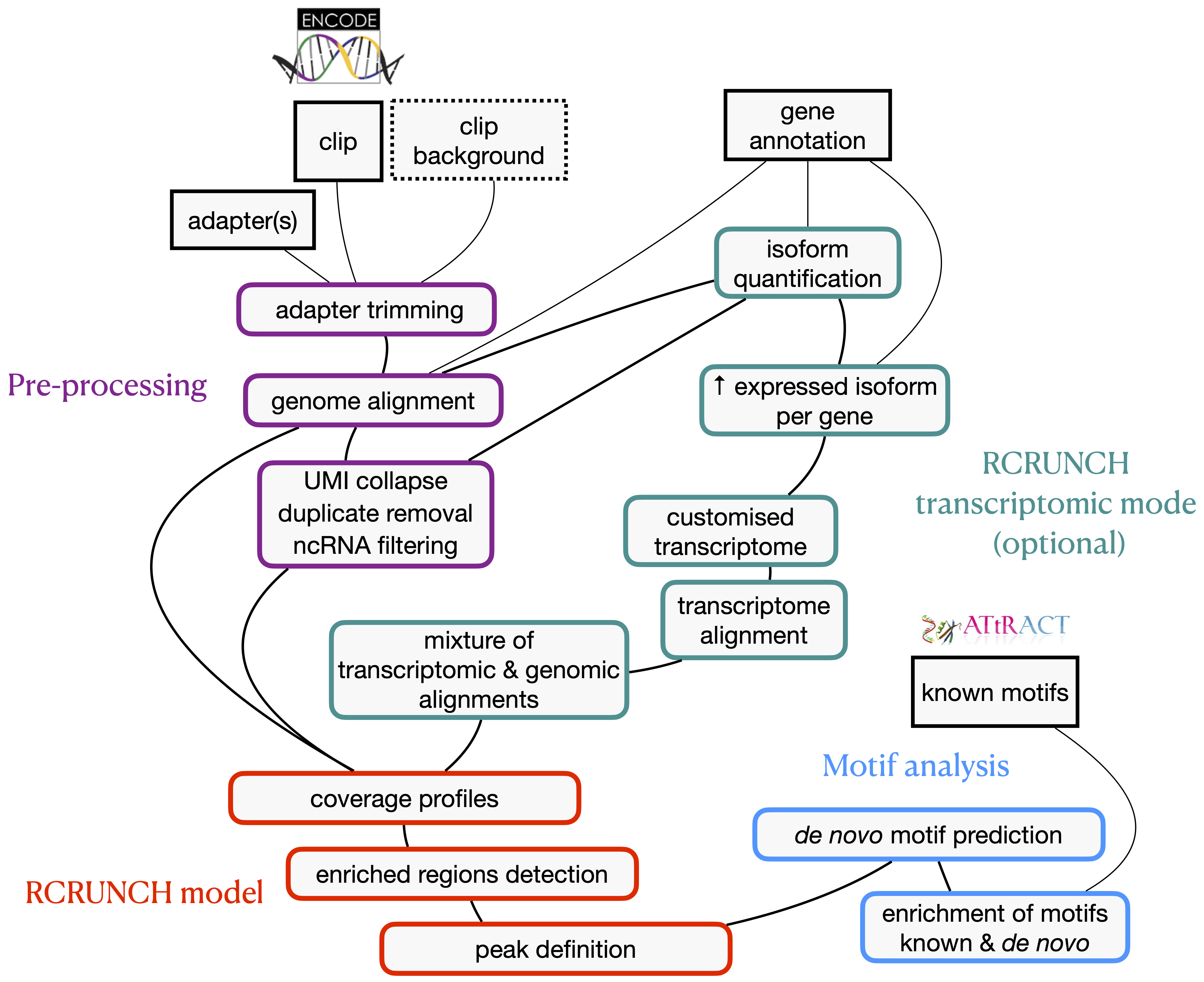RCRUNCH is a workflow that identifies binding sites of RNA Binding Proteins (RBPs) and infers the binding motifs from (e)CLIP data. To accommodate the different types of targets that RBPs have, RCRUNCH offers a few variants and options that can be set by the user. RCRUNCH relies on the Snakemake workflow management system to coordinate the execution of the different components. It can be executed either locally or in a HPC system (e.g. SLURM).
RCRUNCH consists of the following components:
- 3' or 5' adapter removal
- alignment of reads to the reference genome
- elimination of PCR duplicates (or UMIs)
- optional removal of reads that originate from abundant non-coding RNAs (e.g. tRNAs)
If the user chooses the Splice-Junction-aware approach (which we call the "TR" (transcriptomic) for simplicity) of RCRUNCH, some additional steps are performed to identify reads that map across splice junctions. That is, after all the preprocessing steps, the remaining alignments for foreground (CLIP) samples are used to select the most expressed transcript isoform for each gene and construct a dataset-specific transcriptome. Then the genome and transcriptome alignment files are jointly analyzed to identify the highest scoring alignment for each read. Peaks are then detected either on the genome (essentially the pre-mRNAs) or the transcriptome (see RCRUNCH model). This approach allows for the detection and proper quantification of RBP binding sites in the vicinity or even spanning splice junctions.
At the heart of RCRUNCH lies the RCRUNCH model for the detection of RBP-binding regions. Genome/transcriptome-wide identification of peaks corresponding to individual binding sites for an RBP is time consuming. For this reason RCRUNCH implements a two-step process:
- Identify broader genomic regions that are enriched in reads in the foreground (CLIP) compared to the background sample
- Identify individual peaks within these selected broader windows
📖 Please read the "Methods" Section of the manuscript for an extensive description of RCRUNCH.
The last part of RCRUNCH is the de-novo prediction of binding motifs and the computation of enrichment scores for known (e.g. from ATtRACT) and de-novo motifs for the RBP of interest.
The following dependencies need to be installed on your system to be able to install and run RCRUNCH:
- git
- conda and/or mamba
- singularity
✨ Currently, we only support Linux execution. Tested on CentOS 7.5, with miniconda 4.7.12 and Singularity 3.5.2.
A real e.g human CLIP experiment would require:
- ~40 GB of RAM (mapping of human genome and building genome index relies on this requirement)
- ~50 GB of disk space (based on the real life experiment used in the config.yaml). About half of this (~28 GB) is due to the STAR index, which can be reused for several clip experiments,
- 1 core (although the more cores the more you take advantage of the parallelisation of execution)
Go to the desired directory on your file system, then clone the repository and move into the RCRUNCH directory with:
git clone https://github.com/zavolanlab/RCRUNCH.git
cd RCRUNCHWorkflow dependencies can be conveniently installed with the Conda
package manager. If you haven't already, please install Miniconda
for your system (Linux). Be sure to select Python 3 option.
The workflow was built and tested with miniconda 4.7.12.
Other versions are not guaranteed to work as expected.
In addition to Miniconda, you are strongly advised to use Mamba package manager, which -if you don't have it yet- needs to be installed in
the base conda environment with:
conda install mamba -n base -c conda-forgeFor improved reproducibility and reusability of the workflow, each individual step of the workflow runs in its own Singularity container. As a consequence, running this workflow has very few individual dependencies. The container execution requires Singularity to be installed on the system where the workflow is executed. The functional installation of Singularity requires root privileges, and Conda currently only provides Singularity for Linux architectures. If you do not have root privileges on the machine you want to run the workflow please install Singularity separately and in privileged mode, depending on your system. You may have to ask an authorized person (e.g., a systems administrator) to do that. This will almost certainly be required if you want to run the workflow on a high-performance computing (HPC) cluster (which is highly recommended).
After installing Singularity, install the remaining dependencies with:
mamba env create -f install/environment.ymlThis will create an environmnent rcrunch
You can activate the Conda environment with:
conda activate rcrunchTo ensure that the code is working properly you can test it by:
- Activate the Conda environment with:
conda activate rcrunch- Run:
bash test/test_singularity_execution/test_local.sh✨ Note: This test has a running time of ~8 minutes when using 4 cores (Intel(R) Xeon(R) CPU E5-2630 v4 @ 2.20GHz)
or for SLURM workload manager,
bash test/test_singularity_execution/test_slurm.shIn order to run RCRUNCH, please fill in the organism related data and the experiment-dependent parameters for the different samples in the file config.yaml.
✨ For your convenience a pre-filled config.yaml file is available, based on a real example. This can be adapted accordingly. If you want to execute RCRUNCH with this config as is you need to download the required files by running:
bash get_extra_annotation.sh
You can perform a test execution of the pipeline without producing any actual results (referred to as dry run) by running:
snakemake \
-np \
-s workflow/Snakefile \
--profile profiles/local-singularity/ \
--configfile config.yamlThis will show the jobs that will be called upon actual execution.
A directed acyclic graph (dag) of the run can be generated by running:
snakemake --dag -np --use-singularity | dot -Tpng > dag.pngor a rule graph can be generated by running:
snakemake --rulegraph --configfile config.yaml | dot -Tpng > rulegraph.pngFinally you can trigger the pipeline by running:
bash run_local_singularity.sh- We also support execution in the SLURM workload manager. If you use SLURM start running RCRUNCH like this:
bash run_slurm_singularity.sh✨ Note: It might be useful to run rcrunch in the background, with the aid of, for example,
nohup, which will create a nohup.out file containing the info of the run:
nohup bash run_local_singularity.sh &✨ Note: You can use any one of the:
nohup,screenortmux.

